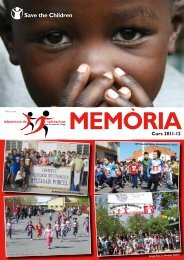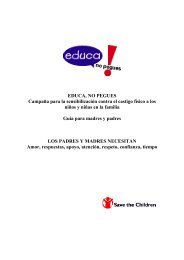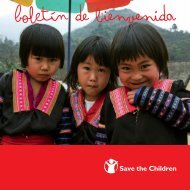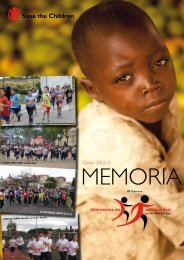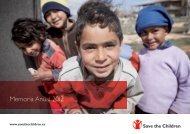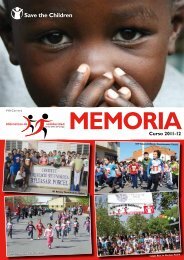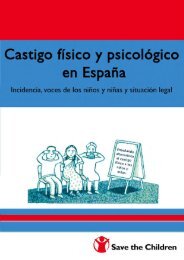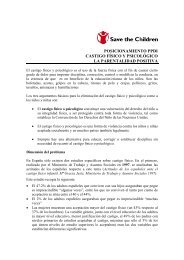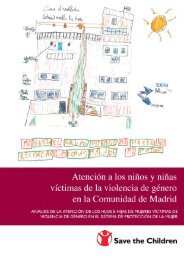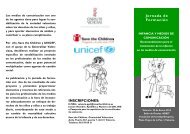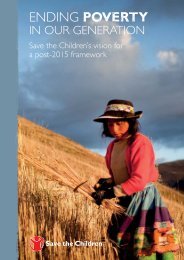Nutrition in the First 1,000 Days - Save the Children
Nutrition in the First 1,000 Days - Save the Children
Nutrition in the First 1,000 Days - Save the Children
Create successful ePaper yourself
Turn your PDF publications into a flip-book with our unique Google optimized e-Paper software.
26 SaviNg liveS aND BUilDiNg a Better FUtUre: loW-coSt SolUtioNS that WorK<br />
over half <strong>the</strong> world’s <strong>Children</strong> do not have access to <strong>the</strong> Lifesav<strong>in</strong>g six<br />
iron folate supplementation<br />
dur<strong>in</strong>g pregnancy<br />
Breastfeed<strong>in</strong>g ß<br />
complementary feed<strong>in</strong>g<br />
vitam<strong>in</strong> a supplementation<br />
Z<strong>in</strong>c for treatment of diarrhea<br />
Water, 1 sanitation 2 and hygiene 3<br />
3 2 1<br />
0% 20% 40% 60% 80% 100%<br />
■ average coverage level <strong>in</strong> develop<strong>in</strong>g countries<br />
■ opportunity to save lives with full scale-up<br />
ß <strong>in</strong>cludes exclusive for <strong>the</strong> first 6 months and any breastfeed<strong>in</strong>g 6-11 months<br />
+ Supplement<strong>in</strong>g neonates <strong>in</strong> asia could br<strong>in</strong>g it up to 7%<br />
estimated deaths prevented<br />
with universal coverage<br />
19% = 68,<strong>000</strong> (maternal)<br />
13% = 990,<strong>000</strong> (child)<br />
6% = 460,<strong>000</strong> (child)<br />
2% = 150,<strong>000</strong> + (child)<br />
4% = 300,<strong>000</strong> (child)<br />
3% = 230,<strong>000</strong> (child)<br />
The number of deaths that could be prevented with universal coverage of <strong>the</strong> “lifesav<strong>in</strong>g six” <strong>in</strong>terventions is calculated by apply<strong>in</strong>g Lancet<br />
estimates of <strong>in</strong>tervention effectiveness (Bhutta et al., 2008 for iron folate, all o<strong>the</strong>rs Jones et al., 2003) to 2010 child and 2008 maternal<br />
mortality. Coverage data are for <strong>the</strong> follow<strong>in</strong>g <strong>in</strong>dicators: % mo<strong>the</strong>rs who took iron dur<strong>in</strong>g pregnancy (90+ days); % children exclusively<br />
breastfed (first 6 months); % children (6-8 months) <strong>in</strong>troduced to soft, semi-soft or solid foods; % children (6-59 months) reached with two<br />
doses of vitam<strong>in</strong> A; % children (6-59 months) with diarrhea receiv<strong>in</strong>g z<strong>in</strong>c; % population with access to safe dr<strong>in</strong>k<strong>in</strong>g water (1); % popula-<br />
tion us<strong>in</strong>g improved sanitation facilities (2); % of mo<strong>the</strong>rs wash<strong>in</strong>g <strong>the</strong>ir hands with soap appropriately (i.e. after handl<strong>in</strong>g stool and before<br />
prepar<strong>in</strong>g food) (3).<br />
—<br />
Data sources: UNiceF. The State of <strong>the</strong> World’s <strong>Children</strong> 2012. (New york: 2012), table 2; Who/UNiceF Jo<strong>in</strong>t Monitor<strong>in</strong>g programme for Water Supply and Sanitation. Progress on Dr<strong>in</strong>k<strong>in</strong>g<br />
Water and Sanitation - 2012 Update. (UNiceF and Who: New york: 2012); Susan horton, Meera Shekar, christ<strong>in</strong>e McDonald, ajay Mahal and Jana Krystene Brooks, Scal<strong>in</strong>g Up <strong>Nutrition</strong>: What<br />
Will it Cost? (World Bank: Wash<strong>in</strong>gton Dc: 2010); recent DhS surveys and valerie curtis, lisa Danquah and robert aunger, “planned, Motivated and habitual hygiene Behaviour:<br />
an eleven country review,” Health Education Research 2009, 24(4):655-673.<br />
<strong>in</strong>Fant and toddLeR Feed<strong>in</strong>g sCoReCaRd<br />
<strong>Save</strong> <strong>the</strong> <strong>Children</strong> presents <strong>the</strong> Infant and Toddler Feed<strong>in</strong>g Scorecard show<strong>in</strong>g<br />
where young children have <strong>the</strong> best nutrition, and where <strong>the</strong>y have <strong>the</strong> worst.<br />
This analysis reveals that <strong>the</strong> develop<strong>in</strong>g world has a lot of room for improvement<br />
<strong>in</strong> early child feed<strong>in</strong>g. Only 4 countries out of 73 score “very good” overall<br />
on measures of young child nutrition. More than two-thirds perform <strong>in</strong> <strong>the</strong><br />
“fair” or “poor” category.<br />
The Scorecard analyzes <strong>the</strong> status of child nutrition <strong>in</strong> 73 priority countries<br />
where children are at <strong>the</strong> greatest risk of dy<strong>in</strong>g before <strong>the</strong>y reach <strong>the</strong> age of 5<br />
or where <strong>the</strong>y are dy<strong>in</strong>g <strong>in</strong> <strong>the</strong> greatest numbers. For each country, it measures<br />
<strong>the</strong> percentage of children who are:<br />
• Put to <strong>the</strong> breast with<strong>in</strong> one hour of birth<br />
• Exclusively breastfed for <strong>the</strong> first 6 months<br />
• Breastfed with complementary food from ages 6-9 months<br />
• Breastfed at age 2<br />
Countries are ranked us<strong>in</strong>g a scor<strong>in</strong>g system that assigns numeric values to<br />
very good, good, fair and poor levels of achievement on <strong>the</strong>se four <strong>in</strong>dicators.<br />
The performance thresholds are consistent with those established by <strong>the</strong> WHO<br />
and USAID’s L<strong>in</strong>kages Project <strong>in</strong> 2003.




